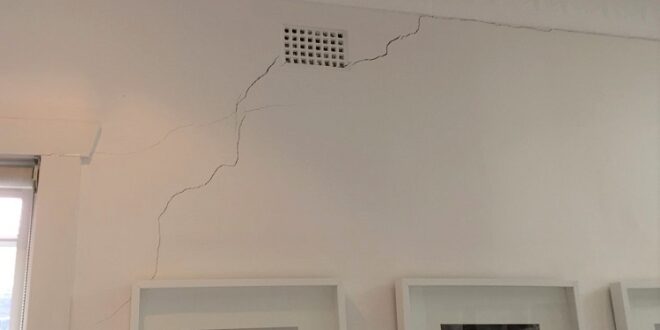Walls can get cracks on them for several different reasons. Depending on the circumstances, the resulting cracks can be of varying nature. Let us explore the different types of cracks that may form on plastered walls and ceilings and what kind of impact each of these types has. Depending on the type of crack, you can easily figure out if it would be a cause of concern for you or if the structure is prone to structural instability in the future.
This information plays a critical role when you are buying or selling any house. For a buyer, it would be a matter of safety and then cost. The same would apply to a seller who would admittedly be more interested in simply finding out how ‘sellable’ the property remains with potential structural issues..
Starting off with cracks formed from ground movement, we see two types:
-
Ground Heave Cracks
This movement is when dehydrated soil in the foundation of the building starts gathering moisture. Being densely packed after desiccation, the return of moisture causes it to expand in the only direction it can, i.e., upward. It accounts for 1.7% of insurance claims made by building owners against structural damage.
-
Subsidence Cracks
Considered to be one of the trickiest structural problems, this happens when the ground under the structure is unable to support load bearing weight. In the UK, subsidence has a direct link with hot and dry summers. The more the earth’s moisture recedes, thre more chances of subsidence. Subsidence can also happen due to the earth beneath any structural load getting washed away. This typically happens because of a drain failure and resultant leaking water adversely affecting ground conditions.
Hairline cracks
Hairline cracks are the least problematic and the most common types that you might see. Typically, these occur if the plaster on the wall shrinks after drying out, indicating that there is no structural damage underneath it. They can also occur if the upper floor’s wooden joists are moved in any way which can lead to cracks appearing on the lower floor. However, these could also lead to a bigger problem depending on the situation.
Where does the crack occur?
The most crucial step in understanding the criticality of the situation is to check which wall is getting cracked. Cracks to Load bearing walls should be monitored carefully as they can pose the most concern if the cracks are progressive. However, internal walls may not all be load-bearing and a reasonably small crack could be deemed as superficial. Houses from the Victorian and Edwardian eras usually have all outer walls bearing the load of the structure and so particular attention should be paid to these.
Cracking Patterns
The patterns you find on your walls can give you an idea of the type of crack you are seeing. It can also indicate what the proper solution would be for cracking.
- Ground heave cracks typically have a stepped look, and they would start from a corner and go towards the center in a stepped style. However, they can occur in the center of the wall and take any direction. The stepped look is the easiest method of identifying these cracks, telling you that your ground is pushing upward.
- Subsidence cracks are vertical in direction and have a much smaller stepping starting from the top and running towards the bottom. While the ground receding downward is also the cause, if you have failing waterlines under the structure, you can immediately identify these cracks. The cracks typically look the same for both mortar and brick structures.
How Do I Deal with the Cracks on My Walls?
Depending on the situation, the steps you may need to take will differ. Here are a few things to keep in mind and check if cracks appear on your walls.
- Observe the wall that is showing cracks and keep a record of the way it changes over time. The best way is to take a photo or video that clearly shows the crack. Continue taking photos at regular intervals and document any changes that may occur. About 12 weeks of observation should be enough to let you know the situation. In case the cracks stop moving after a certain time, there is a chance that the structure has settled itself and you may not need to worry about any structural weakness.
- Call in a professional building surveyor to look at your structural issues. A surveyor can inspect the structure properly and let you know how stable your structure is and even advise you on the next steps.
 HammBurg Be informed with latest news, reviews, entertainment, lifestyle tips, and much more.
HammBurg Be informed with latest news, reviews, entertainment, lifestyle tips, and much more.




